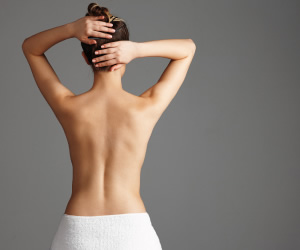
Our vertebral column is the load-bearing axis of our entire body as well as a fundamental pillar of our existence.
It is daily subjected to physical and psychic loads and, if we do not pay proper attention, this could inevitably lead to the knowledge of the number one human’s enemy: back pain.
Too many people suffer from this disorder and you have surely had the chance to experience it, too...
But have you ever wondered when the back pain was born? Do we all suffer from it? And when do we develop the physiological curves?
First of all, let's shed some light on the structure of our back.
Albeit at a superficial glance it may appear single and compact, on a closer inspection we understand that it is made of 34 small bones called vertebrae. Together these vertebrae can be divided into four regions, which we can call, starting from the top, in the following way: cervical, dorsal, lumbar and sacral. In an adult it is rectilinear in the frontal plane and divides the body exactly into two symmetrical parts, while in the sagittal plane it has four curves: two with an anterior convexity and two with a posterior convexity.
The front curves are in the cervical and lumbar regions and are called lordosis, whose characteristic is the mobility, while the back ones are in the dorsal and sacral regions and are denominated kyphosis, whose characteristic is the stiffness. The alternation between more mobile curvatures (lordosis) and more rigid (kyphosis) ones allows us to stay in the upright position, and, at the same time, the great flexibility and mobility, distributing correctly the mechanical stresses.
The curves and the flexibility are important elements to contrast the force of gravity and other external forces. Bones, muscles, joints and lower limbs are designed to support the weight, support and balance the trunk. The physiological curves are therefore beneficial for the spine, giving it a greater ability to cushion the pressures and stresses.
Having established this, we now discover together some interesting facts on our back!
BACK PAIN? AN EVOLVING PROBLEM

According to some studies, the passage from walking on four legs to the standing posture, with the consequent amendment of the spine, has not been exactly perfect. It seems that the lower back pain, which afflicts most of the modern population, derives precisely from some vertebral characteristics of our primate cousins.
The people who suffer more than others from back problems, may have columns similar to those of chimpanzees, less able to withstand the pressure that involves walking on two feet.
IT IS IMPORTANT TO HAVE A NICE SMILE!

Did you know that one of the causes of back pain is linked to dental problems?
Well, the presence of malocclusion and therefore alterations of the masticatory movement, causes tensions that affect the shoulders and the spine.
The mechanism of opening and closing the mandible must be harmonious to ensure, on the one hand the correct speech and on the other the full masticatory functionality.
In the presence, in fact, of a malocclusion, both of these functions can be compromised depending on the severity and cause problems including painful resentments at the level of our back.
TORTURE OR MEDICINE?

Ancient texts are filled of references on how to remedy back pains.
As early as 300 B.C. Hippocrates, after classifying the various angular deformity of the spine, he devised a series of tools to reduce these anomalies.
Among these means stands out the so-called "traction bed" in which a victim was tied upside down and lowered with a rope to relieve the vertebrae by the compression of gravity.
SAY 33!

Why does the doctor place the stethoscope, as cold as an ice cube, at a precise point of the back, just below the base of the scapula to listen to the lungs?
The answer is simple: it is the only chest area free from the scapula bones and just covered by thin muscles, on which it is easier to feel the breath, the so-called "the triangle of auscultation".
VENUS KISSES

Do you happen to know those two small notches on the lower back, just above the B-side?
They are called "the dimples of Venus". These are created during the first years of life and are due to a particular bone conformation. If underlying muscle is absent, these recesses are formed by the contact between the sacrum and the iliac wings of the pelvis.
They are called in this way because the goddess of beauty, together with the squint and the other six defects, had also this peculiarity.
In addition to being considered a hallmark of the figure of Venus, these dimples are seen as a powerful weapon of seduction by most part of the men.
THE POWER OF WOMEN

Although the back curves are equally developed in both men and women, that is, before the outward-facing (thoracic kyphosis and sacrococcygeal) and then those facing inward (cervical and lumbar lordosis), the woman’s spine is more robust and less prone to fracture.
This is because in the process of pregnancy she must be able to support the weight of the belly without tipping forward. The backward inclination of the back goes up to 28 ° above normal!
BLAME THE BRA!

Women’ back pain may also have hidden origins.
One of these is the bra that, because of a wrong choice, it may be the cause of back pain, neck stiffness and even headaches.
The most common mistake is to wear a bra with a too small cup, but with a back part too large. This means that the weight is supported by the shoulders, leading to back pain. And who would ever think about it?
